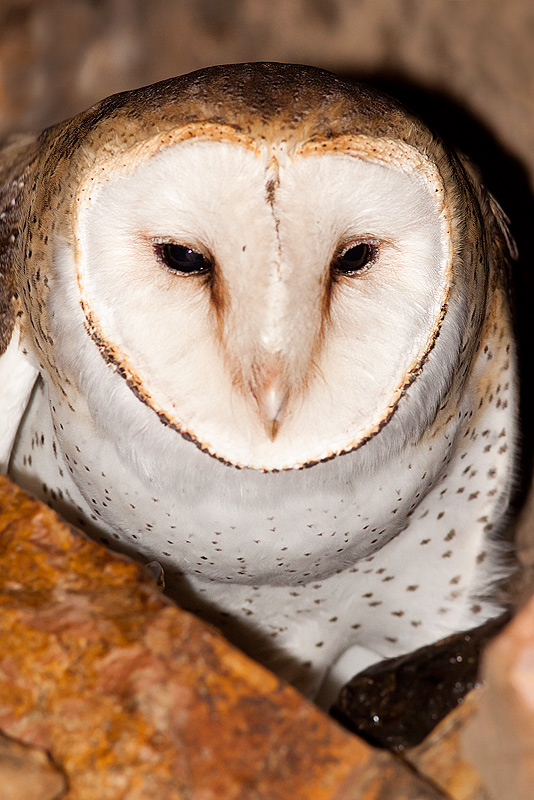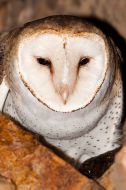Barn Owl
Lechuza de Campanario
Tyto alba
Length: 370mm. Sexes alike. Bill whitish horn; iris very dark brown; facial disc white with a blackish brown spot before the eyes; the feathers of the circle framing the facial disc are golden at the top, from the lower half of the auricular region and below the bill white and black; foreneck, breast, flanks and abdomen white with small blackish mottling; thighs, tarsi and undertail coverts white. Sides of head and neck white shifting to golden towards the back; upper parts of head, hind neck, back and scapulars golden with dark grey mottling and fine undulating blackish streaks and bars as well as small white dots; uppertail coverts as back; upperside of rectrices ochraceous cream, fine and copious irregular and undulating blackish brown bars, the undertail is whitish with five transversal bars. Bend of wing white, lesser wing coverts golden; median and greater coverts golden spotted with grey, fine undulating blackish bars and small white mottling; primary and secondary remiges show cinnamon ochraceous on outer vexillum with a few dark greyish brown bars and fine undulating dark greyish brown barring; the inner vexillum sports a brownish grey longitudinal band along the rachis of feathers, the remainder being white, crossed throughout with a few dark greyish brown bars; the tip of the inner vexillum of primaries is brownish grey with a faint dark greyish brown barring; underwing coverts and axillaries are white with small blackish mottling; underwing coverts covering the base of primaries show dark greyish brown to the outer half; underside of secondaries white, primaries white with brownish grey bands. Toes are greyish brown above and yellowish whitish below. Both sexes are similar in colour but the female is slightly larger. Juveniles are similar to adults but they differ by having the underparts entirely cinnamon ochraceous with feathers blotched at the tip with a white spot trimmed by blackish. Many adult and subadult individuals show ochraceous cream on the breast shading to whitish cream on the abdomen and flanks, dotted all over with small blackish brown mottles; some adults show immaculate white on the entire underparts.
Habitat and behaviour: very easily identified by its large size, coloration and facial disc in the shape of a heart. The Barn Owl is quite common but rather elusive on account of its habit to remain hidden during the day, rarely venturing out in the daylight and becoming active generally at nightfall when it cannot be seen. It can be heard at times with its distinctive call in the form of a shrill rolling hiss.
It is often found in pairs that seek refuge in crevices or holes in cliffs, hollow trees, houses, belfries, towers, barns and ruined buildings. It prefers dark secluded spots, almost invariably giving its back to any source of light, thus making it hard to be found. Associated with human environments, on account of its staple diet that consists mainly of large quantities or rats and voles, it also takes birds, bats, reptiles and insects, thus an unequalled ally to fight off certain plagues.
To fly it skims low. At night when it moves from its roosting site to its foraging grounds, it often flies high and the white of its underparts often flash with the lights of the urban dwellings.
It roosts in hollows in trees, burrows in rocky walls or human dwellings. No nest is built, the eggs being laid directly on the floor of its quiet and dark retreat. Pellets often accumulate in considerable numbers around the feeding or roosting site, or nest, and combined with the stench of the bird’s droppings there is a strong and disagreeable odour. Usually up to ten in number, the eggs are white in colour and, provided food is plentiful, these birds can breed any time of the year. The female is in charge of incubation whilst the male seeks food. Owlets are born clad in a thick coat of white down.
Range: the species Tyto alba is cosmopolitan, its population divided in several races. The race Tyto abla tuidara occurs all over Argentina and, therefore, in Patagonia; also found in South America up to the Amazon.
Illustrated Handbook of the Birds of Patagonia
Kindless: Kovacs Family
|










